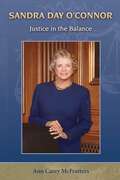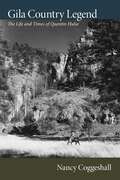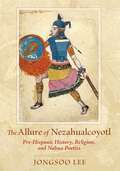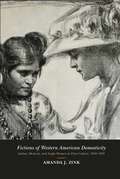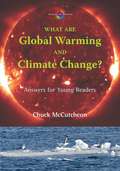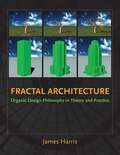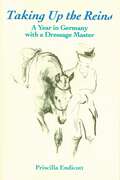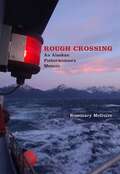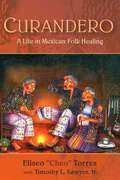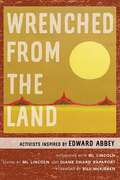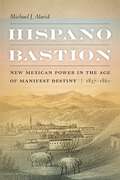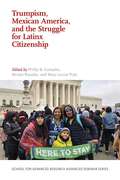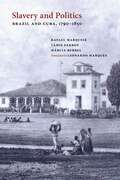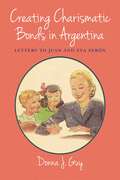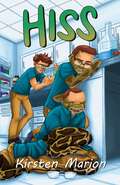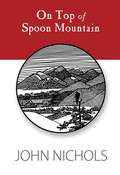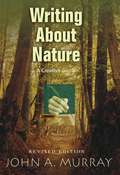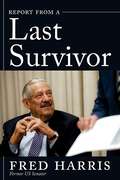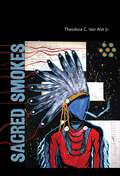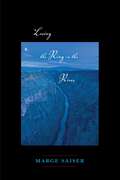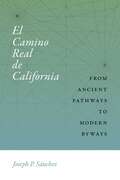- Table View
- List View
Sandra Day O'Connor: Justice in the Balance (Women's Biography Series)
by Ann Carey McFeattersOn July 1, 1981, President Ronald Reagan interviewed Sandra Day O'Connor as a candidate for the United States Supreme Court. A few days later, he called her. Sandra, I'd like to announce your nomination to the Court tomorrow. Is that all right with you? Scared and wondering if this was a mistake, the little-known judge from Arizona was on her way to becoming the first woman justice and one of the most powerful women in the nation. Born in El Paso, Texas, O'Connor grew up on the Lazy B, a cattle ranch that spanned the Arizona-New Mexico border. There she learned lifelong lessons about self-reliance, hard work, and the joy of the outdoors. Ann Carey McFeatters sketches O'Connor's formative years there and at Stanford University and her inability to find a job--law firms had no interest in hiring a woman lawyer. McFeatters writes about how O'Connor juggled marriage, a career in law and politics, three sons, breast cancer, and the demands of fame.In this second volume in the Women's Biography Series, we learn how O'Connor became the Court's most important vote on such issues as abortion, affirmative action, the death penalty, the role of religion in society, and the election of a president, decisions that shaped a generation of Americans.
Gila Country Legend: The Life and Times of Quentin Hulse
by Nancy CoggeshallIf there was ever a ring-tailed roarer of the backwoods of New Mexico, he was Quentin Hulse (1926-2002). Hulse lived and worked most of his life at the bottom of Canyon Creek in the Gila River country of southwestern New Mexico, but his reputation spread far and wide. His western image appeared on a tourist postcard and souvenir license plate in the 1950s. Footage of a lion hunt led by Hulse and his hounds appeared on the Men's Channel in 2005, three years after his passing.Hulse grew up primarily in western New Mexico when that ranch and mining country was still remote and raw. At the age of ten he witnessed a point-blank shooting, the culmination of an old-fashioned frontier feud. He followed his parents between mines and towns until his father established a ranch at Canyon Creek. While serving in the navy during World War II, he landed on the bloody beach at Okinawa. After returning from the war, he was shot in a bar near Silver City during a night of carousing.Hulse was most at home in the rugged Gila Wilderness, in which he ranched and guided for fifty years. With compassion and nuance, Nancy Coggeshall tells the compelling biography of a unique western rancher constantly adjusting to the inroads of modernity into his traditional way of life. Drawing on oral history, archival sources, and her personal association with Hulse and the Gila, she brings this unique westerner, and New Mexican, to life.
The Allure of Nezahualcoyotl: Pre-Hispanic History, Religion, and Nahua Poetics
by Jongsoo LeeNezahualcoyotl (1402-1472), the poet-king of Texcoco, has been described as one of the most important pre-Hispanic figures in Nahua history. Since the conquest, European chroniclers have continually portrayed him as a symbol of Aztec civilization and culture, a wise governor and lawmaker, poet and patron of the arts, and proto-monotheist. Their chronicles have served as sources for anthropologists, historians, and literary critics who focus on these contrived images and continually reproduce the colonial propaganda on Nezahualcoyotl. This, as Jongsoo Lee argues, subsequently leads to a misrepresentation of the history, religion, literature, and politics of pre-Hispanic Mexico that are altered to support such images of Nezahualcoyotl.Lee provides a new assessment of Nezahualcoyotl that critically examines original codices and poetry written in Nahuatl alongside Spanish chronicles in an effort to paint a more realistic portrait of the legendary Aztec figure. Urging scholars away from sources that reinforce a Judeo-Christian perspective of pre-Hispanic history, Lee offers a revision of the colonial images of Nahua history and culture that have continued over the last five hundred years.
Fictions of Western American Domesticity: Indian, Mexican, and Anglo Women in Print Culture, 1850–1950
by Amanda J. ZinkThis work provides a compelling explanation of something that has bedeviled a number of feminist scholars: Why did popular authors like Edna Ferber continue to write conventional fiction while living lives that were far from conventional? Amanda J. Zink argues that white writers like Ferber and Willa Cather avoided the subject of their own domestic labor by writing about the performance of domestic labor by &“others,&” showing that American print culture, both in novels and through advertisements, moved away from portraying women as angels in the house and instead sought to persuade other women to be angels in their houses. Zink further explores lesser-known works such as Mexican American cookbooks and essays in Indian boarding school magazines to show how women writers &“dialoging domesticity&” exemplify the cross-cultural encounters between &“colonial domesticity&” and &“sovereign domesticity.&” By situating these interpretations of literature within their historical contexts, Zink shows how these writers championed and challenged the ideology of domesticity.
What Are Global Warming and Climate Change?: Answers for Young Readers (Barbara Guth Worlds of Wonder Science Series for Young Readers)
by Chuck McCutcheonGlobal warming is one of the most talked about science subjects today.Maybe you have seen pictures of polar bears or other animals stranded atop floating chunks of melting ice. Perhaps you have heard about or lived through extreme weather--hurricanes, floods, water shortages, heat waves, or electricity blackouts.Many of these events can stem from the world getting warmer. As that happens, the climate changes, too. This book helps young readers understand the sciences used to study global warming.Each chapter addresses specific questions about why the temperatures of the earth's air and oceans are rising. The information presented aligns with the findings of the Intergovernmental Panel on Climate Change: that most of the warming observed over the last half-century is due to human activities and that the impacts of global warming will be significantly negative.Using a question-and-answer format supplemented by hands-on activities, this book fosters an understanding of the complex processes at work in global warming while also enabling youngsters to think critically about their future. McCutcheon ends his book by offering young readers productive ways to think about--and act on--changes in the environment contributing to climate change.McCutcheon taps his mastery of a complicated, highly charged topic to permit young readers to become informed consumers of the sciences associated with the most urgent topic of their future--global warming.
Fractal Architecture: Organic Design Philosophy in Theory and Practice
by James HarrisThroughout history, nature has served as an inspiration for architecture and designers have tried to incorporate the harmonies and patterns of nature into architectural form. Alberti, Charles Renee Macintosh, Frank Lloyd Wright, and Le Courbusier are just a few of the well- known figures who have taken this approach and written on this theme. With the development of fractal geometry--the study of intricate and interesting self- similar mathematical patterns--in the last part of the twentieth century, the quest to replicate nature&’s creative code took a stunning new turn. Using computers, it is now possible to model and create the organic, self-similar forms of nature in a way never previously realized.In Fractal Architecture, architect James Harris presents a definitive, lavishly illustrated guide that explains both the &“how&” and &“why&” of incorporating fractal geometry into architectural design.
Taking Up the Reins
by Priscilla EndicottA charming and honest first-hand account, behind-the-scenes look at what dressage training abroad entails. In this personal memoir, the author chronicles the year she spent in Germany studying with the great dressage master Walter Christensen.
Rough Crossing: An Alaskan Fisherwoman's Memoir (River Teeth Literary Nonfiction Prize Series)
by Rosemary McGuireKnowing next to nothing about fishing, Rosemary McGuire signed on to the crew of the Arctic Storm in Homer, Alaska, looking for money and experience. Cold, hard work and starkly sexist harassment were what she found. Here is her story of life on a fishing boat as the only woman crew member. Both an adult coming-of-age tale and a candid look at the Alaskan fishing industry, this is the story of a woman in a man&’s world. Anyone who has ever longed to sail in heavy seas will relish her account of working in an ancient profession that has changed remarkably little over the course of human history.
Curandero: A Life in Mexican Folk Healing
by Torres Eliseo “Cheo” Timothy L. SawyerEliseo Torres, known as Cheo, grew up in the Corpus Christi area of Texas and knew, firsthand, the Mexican folk healing practiced in his home and neighborhood. Later in life, he wanted to know more about the plants and rituals of curanderismo. Torres's story begins with his experiences in the Mexican town of Espinazo, the home of the great curandero El Niño Fidencio (1899-1939), where Torres underwent life-changing spiritual experiences. He introduces us to some of the major figures in the tradition, discusses some of the pitfalls of teaching curanderismo, and concludes with an account of a class he taught in which curanderos from Cuernavaca, Mexico, shared their knowledge with students.Part personal pilgrimage, part compendium of medical knowledge, this moving book reveals curanderismo as both a contemplative and a medical practice that can offer new approaches to ancient problems.From Curandero . . . for centuries, rattlesnakes were eaten to prevent any number of conditions and illnesses, including arthritis and rheumatism. In Mexico and in other Latin American countries, rattlesnake meat is actually sold in capsule form to treat impotence and even to treat cancer. Rattlesnake meat is also dried and ground and sprinkled into open wounds and body sores to heal them, and a rattlesnake ointment is made that is applied to aches and pains as well.
Wrenched from the Land: Activists Inspired by Edward Abbey
by ML LincolnWrenched from the Land features sixteen interviews with some of the most iconic eco-warriors to put themselves on the line for their beliefs. The activists featured in this book are inspired by the late Edward Abbey, one of America&’s uncompromising and irascible defenders of wilderness. The book includes interviews with Terry Tempest Williams, the late Charles Bowden, Sea Shepherd Society founder Paul Watson, Jack Loeffler, Doug Peacock, Ingrid Eisenstadter, John De Puy, Bob Lippman, Derrick Jensen, Shonto Begay, Ken Sanders, Ken Sleight, the late Katie Lee, Executive Director of the Center for Biological Diversity Kieran Suckling, Earth First! cofounder Dave Foreman, and climate activist Tim DeChristopher.Some were among Abbey&’s closest friends and were the inspiration for his irreverent comedic masterpiece, The Monkey Wrench Gang. Here are mesmerizing stories about how they adapted Abbey&’s monkeywrenching ideas into a radical blueprint for direct action. Their achievements—as ingenious and fierce as the individuals in this book—will encourage readers to discover their own pathways toward positive change.
Hispano Bastion: New Mexican Power in the Age of Manifest Destiny, 1837-1860
by Michael J. AlaridIn this groundbreaking study, historian Michael J. Alarid examines New Mexico&’s transition from Spanish to Mexican to US control during the nineteenth century and illuminates how emerging class differences played a crucial role in the regime change. After Mexico won independence from Spain in 1821, trade between Mexico and the United States attracted wealthy Hispanos into a new market economy and increased trade along El Camino Real, turning it into a burgeoning exchange route. As landowning Hispanos benefited from the Santa Fe trade, traditional relationships between wealthy and poor Nuevomexicanos—whom Alarid calls patrónes and vecinos—started to shift. Far from being displaced by US colonialism, wealthy Nuevomexicanos often worked in concert with new American officials after US troops marched into New Mexico in 1846, and in the process, Alarid argues, the patrónes abandoned their customary obligations to vecinos, who were now evolving into a working class. Ultimately wealthy Nuevomexicanos, the book argues, succeeded in preserving New Mexico as a Hispano bastion, but they did so at the expense of poor vecinos.
Lord of the Dawn: The Legend of Quetzalcóatl
by Rudolfo AnayaThe legend of Quetzalcóatl is the enduring epic myth of Mesoamerica. The gods create the universe, but man must carefully tend to the harmony of the world. Without spiritual attention to harmony, chaos may reign, destroying the universe and civilization.The ancient Mexicans, like other peoples throughout the world, wrestled with ideas and metaphors by which to know the Godhead and developed their own concepts about their relationship to the universe. Quetzalcóatl came to the Toltecs to teach them art, agriculture, peace, and knowledge. He was a redeemer god, and his story inspires, instructs, and entertains, as do all the great myths of the world.Now available in paperback, the Lord of the Dawn is Anaya&’s exploration of the cosmology and the rich and complex spiritual thought of his Native American ancestors. The story depicts the daily world of man, the struggle between the peacemakers and the warmongers, and the world of the gods and their role in the life of mankind.
Clinton Anderson Philosophy
by Clinton AndersonThe key to enjoying a safe, fun, and fulfilling partnership with your horse is having the knowledge and confidence to lead and train him. All great partnerships are based on three elements: trust, respect, and communication. Whenever one element is lacking, the partnership fails to form or ceases to exist. When it comes to interacting with horses, we unintentionally tend to be our own worst enemies. By design, horses and humans perceive the world from opposite ends of the scale: horses are prey animals with an ingrained flight or fight response, and humans are predators. Because of this, before you train a horse, you have to understand basic horse psychology and what makes your horse tick. When you know how the horse processes his thoughts and why he does the things that he does, both good and bad, you can accomplish anything. If you don't understand how your horse perceives the world around him, then you will struggle with your horsemanship goals. Clinician Clinton Anderson knows good horsemanship isn't always easy. With over 20 years of experience working with horses and helping people safely train them, Clinton has become an expert at bringing out the best in both. In this highly illustrated book, he shares his philosophy, knowledge and wisdom, detailing what he feels every person should know about horses before working with them. Breaking down the crucial elements of his method of horsemanship, Clinton explains how to become an effective leader that your horses will look to for guidance and how to successfully start a mutually enjoyable partnership. Readers will learn what motivates horses, the basics of respect and why it must be established, and the role pressure and body language play in communicating. Clinton prescribes a tried-and-true formula to train a well broke horse and discusses the three elements that go into becoming an all-around great horseman. Filled with commonsense explanations and personal anecdotes from Clinton's life, the lessons in Philosophy provide the instruction and inspiration needed to help you achieve your horsemanship dreams.
Many Brave Fools
by Susan E. ConleyCodependency, a compulsive behavior sometimes known as &“relationship addiction,&” is often characterized by a dysfunctional, one-sided relationship that is emotionally destructive–even abusive. For years Susan Conley found herself trapped, married to an addict whose health, welfare, and safety she valued far above her own. Over time she watched as she lost contact with her own needs, desires, and sense of self. But then at forty-two, after yet another crisis came to an anticlimactic resolution that left nothing healed and little to hope for, she decided, having never so much as touched a horse, to take up riding. Here, with humor and honesty, Conley chronicles her experiences, sharing how her pledge to rediscover herself following her divorce was aided, abetted, and challenged by the horses in her life. &“They were as large a part of my recovery as were any of the self-help books I read, personal development workshops I did, and 12-step meetings I attended,&” she writes. &“The struggle to heal the wounds of a dysfunctional marriage was actually made easier via the real wounds received from horseback riding.&”Many Brave Foolsexplores the ways in which horses enriched Conley's life, and how the process of making herself into a rider also helped her become the person she most wanted to be: not the &“ex-wife of an addict,&” but a responsive, confident, even courageous woman, entering the prime of her life.
An Archaeology of Architecture: Photowriting the Built Environment
by Dennis TedlockPage by page, this book takes us on a journey through the built world that ranges from Greece to Guatemala and from New York to San Francisco. Tedlock practices what he calls photowriting, a creative process that brings photographer and writer together in the same person. It may be true enough that a photograph can show more than words can say, but it is equally true that words can say more than a photograph can show. A third space opens up in the middle, where the viewer reader can look back and forth between image and text at will.Tedlock looks at the built world with the eye of an archaeologist and ethnographer His long experience as a fieldworker has made him acutely aware of the ways in which buildings are continuously altered by human actions and natural forces Anthropology assigns ruins to archaeology and structures currently in use to ethnology, but Tedlock reminds the viewer that an occupied building bears marks of the same processes that produce archaeological remains. As he puts it, &“Whenever I look around at the worlds humans build for themselves, I see archaeology in the making.&”
Trumpism, Mexican America, and the Struggle for Latinx Citizenship (School for Advanced Research Advanced Seminar Series)
by Renato Rosaldo Mary Louise Pratt Phillip B. GonzalesFor Latinx people living in the United States, Trumpism represented a new phase in the long-standing struggle to achieve a sense of belonging and full citizenship. Throughout their history in the United States, people of Mexican descent have been made to face the question of how they do or do not belong to the American social fabric and polity. Structural inequality, dispossession, and marginalized citizenship are a foundational story for Mexican Americans, one that entered a new phase under Trumpism. This volume situates this new phase in relation to what went before, and it asks what new political possibilities emerged from this dramatic chapter in our history. What role did anti-Mexicanism and attacks on Latinx people and their communities play in Trump&’s political rise and presidential practices? Driven by the overwhelming political urgency of the moment, the contributors to this volume seek to frame Trumpism&’s origins and political effects.Published in Association with School for Advanced Research Press.
Slavery and Politics: Brazil and Cuba, 1790-1850
by Rafael Marquese Tâmis Parron Berbel MárciaThe politics of slavery and slave trade in nineteenth-century Cuba and Brazil is the subject of this acclaimed study, first published in Brazil in 2010 and now available for the first time in English. Cubans and Brazilians were geographically separate from each other, but they faced common global challenges that unified the way they re-created their slave systems between 1790 and 1850 on a basis completely departed from centuries-old colonial slavery. Here the authors examine the early arguments and strategies in favor of slavery and the slave trade and show how they were affected by the expansion of the global market for tropical goods, the American Revolution, the Haitian Revolution, the collapse of Iberian monarchies, British abolitionism, and the international pressure opposing the transatlantic slave trade. This comprehensive survey contributes to the comparative history of slavery, placing the subject in a global context rather than simply comparing the two societies as isolated units.
Creating Charismatic Bonds in Argentina: Letters to Juan and Eva Perón (Diálogos Series)
by Donna J. GuyIn collecting hundreds of letters to Juan and Eva by everyday people as well as from correspondence solicited by Juan Perón, this book promotes a view that charismatic bonds in Argentina have been formed as much by Argentines as by their leaders, demonstrating how letter writing at that time instilled a sense of nationalism and unity, particularly during the first Five Year Plan campaign conducted in 1946. It goes beyond the question of how charisma influenced elections and class affiliation to address broader implications. The letters offer a new methodology to study the formation of charisma in literate countries where not just propaganda and public media but also private correspondence defined and helped shape political polices. Focusing on the first era of Peronism, from 1946 to 1955, this work shows how President Perón and the First Lady created charismatic ways to link themselves to Argentine supporters through letter writing.
Hiss
by Kirsten MarionWhen a bullied boy is unexpectedly turned into a python, his opportunity for revenge comes with complications.Twelve-year-old Max is a scientist, a pioneer eager to discover the secrets of the universe, a young mind alight with hypotheses and theories waiting to be proven. Too bad nobody—not the bullies at school, the new girl Darya, or worst of all, his own dad—can see it. They only see him as a shy, nerdy kid. If they see him at all.But everything changes when Max transforms into a giant python after an accident in his dad&’s laboratory. He has cool new senses, powerful muscles, and an entirely different perspective to explore. This could be his chance to be strong and courageous!But when rumours of a boy-eating snake go viral and Max&’s animal instincts grow harder to control, Max realizes that being a wild snake in a suburban world is dangerous.If he doesn't find his way back to his true form, he risks losing his humanity forever. But first, he must convince others of his identity and learn to see himself in a new way.Hiss is a story of transformation, overcoming fears, and building relationships.
On Top of Spoon Mountain
by John NicholsJonathan Kepler wants to climb Spoon Mountain with his grown son and daughter on his sixty-fifth birthday in three weeks. The kids, Ben and Miranda, think he&’s crazy. For starters, Spoon Mountain is almost the tallest alpine peak in New Mexico. Jonathan&’s health is terrible. Still reeling from his third, nearly fatal, divorce, he has a rotten heart, serious asthma, and a fed-up girlfriend who is about to drop him like a bad habit. Once a celebrated novelist, Hollywood screenwriter, and environmental activist, Jonathan is now tottering at the ragged end of his career and yearning to make amends to his children for his past sins before it&’s too late.Years ago, Spoon Mountain was very special to the Kepler family. They once shared halcyon days in the wilderness. Can they go home again? Does Spoon Mountain offer redemption . . . or annihilation? And why is getting there so laden with pratfalls?John Nichols is at his hilarious and poignant best in this rollicking tale of love, anarchy, and the awesome Rocky Mountains. It is drop-dead comedy with an inspiring and beautiful message.
Writing About Nature: A Creative Guide, Revised Edition.
by John A. MurrayOriginally published by the Sierra Club in 1995, this handbook has already helped thousands of aspiring writers, scholars, and students share their experiences with nature and the outdoors. Using exercises and examples, John Murray covers genres, techniques, and publication issues. He uses examples from such masters as Barry Lopez, Annie Dillard, Larry McMurtry, Edward Abbey, Ernest Hemingway, and Henry David Thoreau. Also included are recommended readings, a directory of creative writing programs, professional organizations for writers, and a directory of environmental organizations. This revised edition includes a new chapter on nature writing and environmental activism.Nature is our grandest and oldest home, older than language, grander than consciousness. John Murray knows that in his bones, and he shares his knowledge generously with anyone who opens this book. Whether you write about the earth for publication or only for deepening your perceptions, you will find keen-eyed guidance here. - Scott Russell Sanders, author of Staying Put
Report from a Last Survivor
by Fred HarrisFred Harris is the last surviving member of the Kerner Rights Commission, famously created by President Lyndon Johnson following the terrible riots, disorders, and violent protests that exploded in so many of America&’s cities in the &“long hot summer&” of 1967. He is the last survivor of the 1964 &“Four Back Bench US Senators,&” which consisted of Walter Mondale of Minnesota, Joseph Tydings of Maryland, Fred Harris of Oklahoma, and Robert Kennedy of New York. He is also the senior surviving former member of the US Senate and one of two &“last surviving&” Democratic presidential candidates to run in 1976—the other being President Jimmy Carter Jr.Report from a Last Survivor tells Fred Harris&’s many stories: some serious, some funny, and all true. Each story forms a part of this report of a last survivor, a long look back over ninety-three years and counting of a rich life of public service and personal commitment.
Sacred Smokes
by Theodore C. Van Alst Jr.Growing up in a gang in the city can be dark. Growing up Native American in a gang in Chicago is a whole different story. This book takes a trip through that unexplored part of Indian Country, an intense journey that is full of surprises, shining a light on the interior lives of people whose intellectual and emotional concerns are often overlooked. This dark, compelling, occasionally inappropriate, and often hilarious linked story collection introduces a character who defies all stereotypes about urban life and Indians. He will be in readers&’ heads for a long time to come.
Losing the Ring in the River (Mary Burritt Christiansen Poetry Series)
by Marge SaiserSpare and incisive, the poems in Losing the Ring in the River deal with three strong women—Clara, Emma, and Liz, women who are tough, often sassy, and have dreams that aren&’t quelled by the realities they face. Saiser deftly explores the undercurrents connecting three generations and is at her most powerful when she explores how lives are restricted and sometimes painfully damaged by what people cannot or will not share with one another. Saiser&’s poetry is as harsh as it is beautiful; she avoids resolutions and easy endings, focusing instead on the small, hard-won victories that each woman experiences in her life and in her love of those around her.
El Camino Real de California: From Ancient Pathways to Modern Byways (Querencias Series)
by Joseph P. SánchezThe arrival of Spaniards in 1769 served as a defining moment for California&’s future. They described the First Peoples and their cultures and provided a window into the evolution of California&’s Camino Real. In an effort to establish the Camino Real de California as a UNESCO World Heritage Site, Joseph P. Sánchez explores the rich history of the path running from San Diego to San Francisco in this significant study. While records capture the stories and legends of the Camino Real there is little information on the exact ground route. Sánchez utilizes historical and archaeological literature and the documentation from Spanish and Mexican archives to begin the much-needed process of authentication of this braided corridor to further establish the Camino Real de California&’s integrity and valuable history, which is shared with Spain, Mexico, and Native American tribes. Their story is part of the patrimony of the Camino Real de California, which ought to be authenticated, preserved, and protected for future generations to enjoy.
